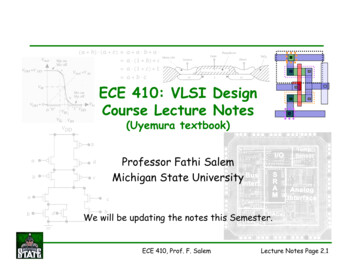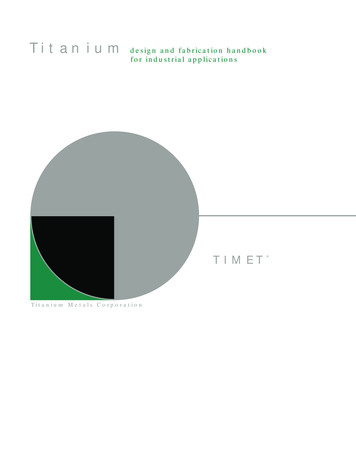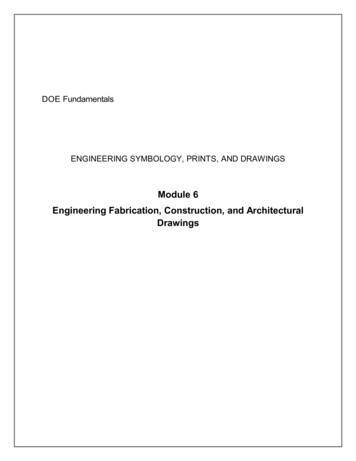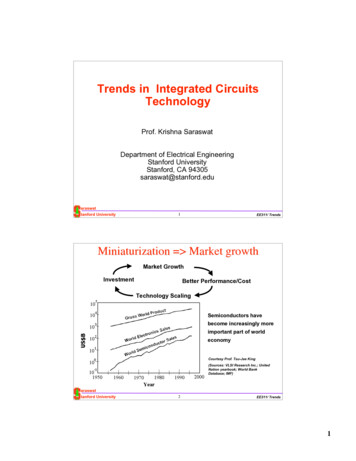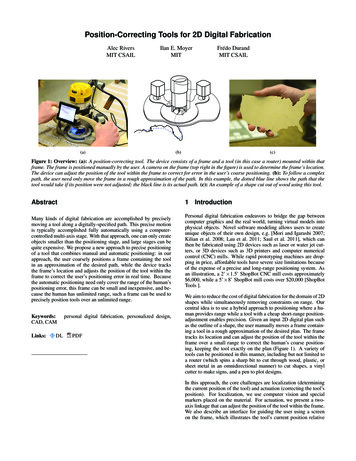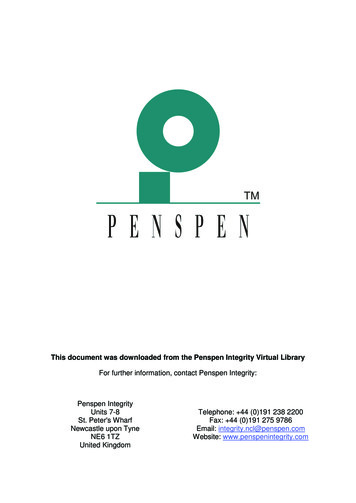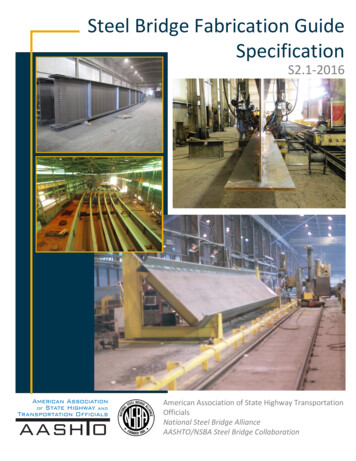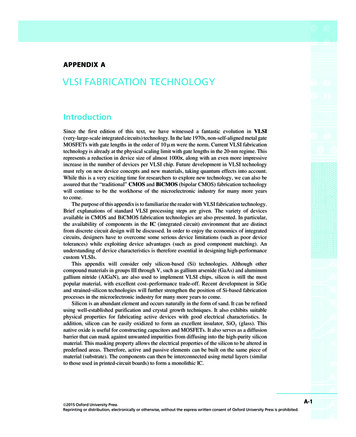
Transcription
APPENDIX AVLSI FABRICATION TECHNOLOGYIntroductionSince the first edition of this text, we have witnessed a fantastic evolution in VLSI(very-large-scale integrated circuits) technology. In the late 1970s, non-self-aligned metal gateMOSFETs with gate lengths in the order of 10 μm were the norm. Current VLSI fabricationtechnology is already at the physical scaling limit with gate lengths in the 20-nm regime. Thisrepresents a reduction in device size of almost 1000x, along with an even more impressiveincrease in the number of devices per VLSI chip. Future development in VLSI technologymust rely on new device concepts and new materials, taking quantum effects into account.While this is a very exciting time for researchers to explore new technology, we can also beassured that the “traditional” CMOS and BiCMOS (bipolar CMOS) fabrication technologywill continue to be the workhorse of the microelectronic industry for many more yearsto come.The purpose of this appendix is to familiarize the reader with VLSI fabrication technology.Brief explanations of standard VLSI processing steps are given. The variety of devicesavailable in CMOS and BiCMOS fabrication technologies are also presented. In particular,the availability of components in the IC (integrated circuit) environment that are distinctfrom discrete circuit design will be discussed. In order to enjoy the economics of integratedcircuits, designers have to overcome some serious device limitations (such as poor devicetolerances) while exploiting device advantages (such as good component matching). Anunderstanding of device characteristics is therefore essential in designing high-performancecustom VLSIs.This appendix will consider only silicon-based (Si) technologies. Although othercompound materials in groups III through V, such as gallium arsenide (GaAs) and aluminumgallium nitride (AlGaN), are also used to implement VLSI chips, silicon is still the mostpopular material, with excellent cost–performance trade-off. Recent development in SiGeand strained-silicon technologies will further strengthen the position of Si-based fabricationprocesses in the microelectronic industry for many more years to come.Silicon is an abundant element and occurs naturally in the form of sand. It can be refinedusing well-established purification and crystal growth techniques. It also exhibits suitablephysical properties for fabricating active devices with good electrical characteristics. Inaddition, silicon can be easily oxidized to form an excellent insulator, SiO2 (glass). Thisnative oxide is useful for constructing capacitors and MOSFETs. It also serves as a diffusionbarrier that can mask against unwanted impurities from diffusing into the high-purity siliconmaterial. This masking property allows the electrical properties of the silicon to be altered inpredefined areas. Therefore, active and passive elements can be built on the same piece ofmaterial (substrate). The components can then be interconnected using metal layers (similarto those used in printed-circuit boards) to form a monolithic IC. 2015 Oxford University PressReprinting or distribution, electronically or otherwise, without the express written consent of Oxford University Press is prohibited.A-1
A-2 Appendix AVLSI Fabrication TechnologyA.1 IC Fabrication StepsThe basic IC fabrication steps will be described in the following sections. Some of these stepsmay be carried out many times, in different combinations and/or processing conditions duringa complete fabrication run.A.1.1 Silicon WafersThe starting material for modern integrated circuits is very-high-purity, single-crystal silicon.The material is initially grown as a single crystal ingot. It takes the shape of a steel-gray solidcylinder 10 cm to 30 cm in diameter and can be one to two meters in length. This crystalis then sawed (like a loaf of bread) to produce circular wafers that are 400 μm to 600 μmthick (a micrometer, or micron, μm, is a millionth of a meter). The surface of the wafer isthen polished to a mirror finish using chemical and mechanical polishing (CMP) techniques.Semiconductor manufacturers usually purchase ready-made silicon wafers from a supplierand rarely start their fabrication process in ingot form.The basic electrical and mechanical properties of the wafer depend on the orientationof the crystalline structure, the impurity concentrations, and the type of impurities present.These variables are strictly controlled during crystal growth. A specific amount of impuritiescan be added to the pure silicon in a process known as doping. This allows the alteration ofthe electrical properties of the silicon, in particular its resistivity. Depending on the types ofimpurity, either holes (in p-type silicon) or electrons (in n-type silicon) can be responsiblefor electrical conduction. If a large number of impurity atoms is added, the silicon willbe heavily doped (e.g., concentration 1018 atoms/cm 3 ). When designating the relativedoping concentrations in semiconductor material, it is common to use the and – symbols. Aheavily doped (low-resistivity) n-type silicon wafer is referred to as n material, while a lightlydoped material (e.g., concentration 1016 atoms/cm 3 ) is referred to as n . Similarly, p and p designations refer to the heavily doped and lightly doped p-type regions, respectively.The ability to control the type of impurities and the doping concentration in the silicon permitsthe formation of diodes, transistors, and resistors in integrated circuits.A.1.2 OxidationIn oxidation, silicon reacts with oxygen to form silicon dioxide (SiO2 ). To speed up thischemical reaction, it is necessary to carry out the oxidation at high temperatures (e.g.,1000–1200 C) and inside ultraclean furnaces. To avoid the introduction of even smallquantities of contaminants (which could significantly alter the electrical properties of thesilicon), it is necessary to operate in a clean room . Particle filters are used to ensure that theairflow in the processing area is free from dust. All personnel must protect the clean-roomenvironment by wearing special lint-free clothing that covers a person from head to toe.The oxygen used in the reaction can be introduced either as a high-purity gas (referred toas a “dry oxidation”) or as steam (forming a “wet oxidation”). In general, wet oxidation hasa faster growth rate, but dry oxidation gives better electrical characteristics. The thermallygrown oxide layer has excellent electrical insulation properties. The dielectric strength forSiO2 is approximately 107 V/cm. It has a dielectric constant of about 3.9, and it can be usedto form excellent MOS capacitors. Silicon dioxide can also serve as an effective mask againstmany impurities, allowing the introduction of dopants into the silicon only in regions that arenot covered with oxide.Silicon dioxide is a transparent film, and the silicon surface is highly reflective. If whitelight is shone on an oxidized wafer, constructive and destructive interference will cause 2015 Oxford University PressReprinting or distribution, electronically or otherwise, without the express written consent of Oxford University Press is prohibited.
A.1 IC Fabrication Stepscertain colors to be reflected. The wavelengths of the reflected light depend on the thicknessof the oxide layer. In fact, by categorizing the color of the wafer surface, one can deducethe thickness of the oxide layer. The same principle is used by more sophisticated opticalinferometers to measure film thickness. On a processed wafer, there will be regions withdifferent oxide thicknesses. The colors can be quite vivid and are immediately obvious whena finished wafer is viewed with the naked eye.A.1.3 PhotolithographyMass production with economy of scale is the primary reason for the tremendous impact VLSIhas had on our society. The surface patterns of the various integrated-circuit components canbe defined repeatedly using photolithography. The sequence of photolithographic steps is asillustrated in Fig. A.1.The wafer surface is coated with a photosensitive layer called photoresist, using a spin-ontechnique. After this, a photographic plate with drawn patterns (e.g., a quartz plate withchromium layer for patterning) will be used to selectively expose the photoresist under adeep ultraviolet illumination (UV). The exposed areas will become softened (for positivephotoresist). The exposed layer can then be removed using a chemical developer, causing themask pattern to be duplicated on the wafer. Very fine surface geometries can be reproducedaccurately by this technique. Furthermore, the patterns can be projected directly onto the wafer,or by using a separate photomask produced by a 10x “step and repeat” reduction techniqueas shown in Fig. A.2.The patterned photoresist layer can be used as an effective masking layer to protectmaterials below from wet chemical etching or reactive ion etching (RIE). Silicon dioxide,silicon nitride, polysilicon, and metal layers can be selectively removed using the appropriateetching methods (see next section). After the etching step(s), the photoresist is stripped away,leaving behind a permanent pattern of the photomask on the wafer surface.To make this process even more challenging, multiple masking layers (which can numbermore than 20 in advanced VLSI fabrication processes) must be aligned precisely on top ofPhotomaskSiO2 layer to bepatternedSilicon substrateLightPhotoresistPhotoresistSilicon substrateSilicon substrateSpin-on photoresistAlign and exposePatterned wafersSilicon substrateSilicon substrateSilicon substratePhotoresist removalEtching (wet or dry)DevelopmentSilicon substrateSilicon substrateSilicon igure A.1 Photolithography using positive or negative photoresist. 2015 Oxford University PressReprinting or distribution, electronically or otherwise, without the express written consent of Oxford University Press is prohibited.A-3
A-4 Appendix AVLSI Fabrication Technologyx10 ReticleStep and repeatcameraActual photomaskMask alignerPatternedwaferFigure A.2 Conceptual illustration of a step-and-repeat reduction technique to facilitate the mass productionof integrated circuits.previous layers. This must be done with even finer precision than the minimum geometrysize of the masking patterns. This requirement imposes very critical mechanical and opticalconstraints on the photolithography equipment.A.1.4 EtchingTo permanently imprint the photographic patterns onto the wafer, chemical (wet) etchingor RIE dry etching procedures can be used. Chemical etching is usually referred to as wetetching. Different chemical solutions can be used to remove different layers. For example,hydrofluoric (HF) acid can be used to etch SiO2 , potassium hydroxide (KOH) for silicon,phosphoric acid for aluminum, and so on. In wet etching, the chemical usually attacks theexposed regions that are not protected by the photoresist layer in all directions (isotropicetching). Depending on the thickness of the layer to be etched, a certain amount of undercutwill occur. Therefore, the dimension of the actual pattern will differ slightly from the originalpattern. If exact dimension is critical, RIE dry etching can be used. This method is essentiallya directional bombardment of the exposed surface using a corrosive gas (or ions). The crosssection of the etched layer is usually highly directional (anisotropic etching) and has thesame dimension as the photoresist pattern. A comparison between isotropic and anisotropicetching is given in Fig. A.3.A.1.5 DiffusionDiffusion is a process by which atoms move from a high-concentration region to a lowconcentration region. This is very much like a drop of ink dispersing through a glass ofwater except that it occurs much more slowly in solids. In VLSI fabrication, this is a methodto introduce impurity atoms (dopants) into silicon to change its resistivity. The rate at whichdopants diffuse in silicon is a strong function of temperature. Diffusion of impurities is usuallycarried out at high temperatures (1000–1200 C) to obtain the desired doping profile. Whenthe wafer is cooled to room temperature, the impurities are essentially “frozen” in position. 2015 Oxford University PressReprinting or distribution, electronically or otherwise, without the express written consent of Oxford University Press is prohibited.
A.1 IC Fabrication sistPhotoresistSiO2SiO2Silicon substrateSilicon substrate(a)(b)Figure A.3 (a) Cross-sectional view of an isotropic oxide etch with severe undercut beneath the photoresistlayer. (b) Anisotropic etching, which usually produces a cross section with no undercut.The diffusion process is performed in furnaces similar to those used for oxidation. The depthto which the impurities diffuse depends on both the temperature and the processing time.The most common impurities used as dopants are boron, phosphorus, and arsenic. Boronis a p-type dopant, while phosphorus and arsenic are n-type dopants. These dopants can beeffectively masked by thin silicon dioxide layers. By diffusing boron into an n-type substrate,a pn junction is formed (diode). If the doping concentration is heavy, the diffused layer canalso be used as a conducting layer with very low resistivity.A.1.6 Ion ImplantationIon implantation is another method used to introduce impurities into the semiconductorcrystal. An ion implanter produces ions of the desired dopant, accelerates them by an electricfield, and allows them to strike the semiconductor surface. The ions become embedded in thecrystal lattice. The depth of penetration is related to the energy of the ion beam, which can becontrolled by the accelerating-field voltage. The quantity of ions implanted can be controlledby varying the beam current (flow of ions). Since both voltage and current can be accuratelymeasured and controlled, ion implantation results in impurity profiles that are much moreaccurate and reproducible than can be obtained by diffusion. In addition, ion implantation canbe performed at room temperature. Ion implantation normally is used when accurate controlof the doping profile is essential for device operation.A.1.7 Chemical Vapor DepositionChemical vapor deposition (CVD) is a process by which gases or vapors are chemicallyreacted, leading to the formation of solids on a substrate. CVD can be used to deposit variousmaterials on a silicon substrate including SiO2 , Si3 N4 , polysilicon, and so on. For instance, ifsilane gas and oxygen are allowed to react above a silicon substrate, the end product, silicondioxide, will be deposited as a solid film on the silicon wafer surface. The properties of theCVD oxide layer are not as good as those of a thermally grown oxide, but they are sufficientto allow the layer to act as an electrical insulator. The advantage of a CVD layer is that theoxide deposits at a faster rate and a lower temperature (below 500 C).If silane gas alone is used, then a silicon layer will be deposited on the wafer. If thereaction temperature is high enough (above 1000 C), the layer deposited will be a crystallinelayer (assuming that there is an exposed crystalline silicon substrate). Such a layer is calledan epitaxial layer, and the deposition process is referred to as epitaxy instead of CVD. Atlower temperatures, or if the substrate surface is not single-crystal silicon, the atoms will notbe able to aligned along the same crystalline direction. Such a layer is called polycrystalline 2015 Oxford University PressReprinting or distribution, electronically or otherwise, without the express written consent of Oxford University Press is prohibited.A-5
A-6 Appendix AVLSI Fabrication Technology81611Figure A.4 Examples of an 8-pin plastic dual-in-line IC package and a 16-pin surface-mount package.silicon (poly Si), since it consists of many small crystals of silicon aligned in random fashion.Polysilicon layers are normally doped very heavily to form highly conductive regions thatcan be used for electrical interconnections.A.1.8 MetallizationThe purpose of metallization is to interconnect the various components (transistors, capacitors,etc.) to form the desired integrated circuit. Metallization involves the deposition of a metalover the entire surface of the silicon. The required interconnection pattern is then selectivelyetched. The metal layer is normally deposited via a sputtering process. A pure metal disk (e.g.,99.99% aluminum target) is placed under an Ar (argon) ion gun inside a vacuum chamber.The wafers are also mounted inside the chamber above the target. The Ar ions will not reactwith the metal, since argon is a noble gas. However, the ions are made to physically bombardthe target and literally knock metal atoms out of the target. These metal atoms will thencoat all the surface inside the chamber, including the wafers. The thickness of the metalfilm can be controlled by the length of the sputtering time, which is normally in the rangeof 1 to 2 minutes. The metal interconnects can then be defined using photolithography andetching steps.A.1.9 PackagingA finished silicon wafer may contain several hundreds of finished circuits or chips. A chipmay contain from 10 to more than 108 transistors; each chip is rectangular and can be upto tens of millimeters on a side. The circuits are first tested electrically (while still in waferform) using an automatic probing station. Bad circuits are marked for later identification.The circuits are then separated from each other (by dicing), and the good circuits (dies) aremounted in packages (headers). Examples of such IC packages are given in Fig. A.4. Fine goldwires are normally used to interconnect the pins of the package to the metallization patternon the die. Finally, the package is sealed using plastic or epoxy under vacuum or in an inertatmosphere.A.2 VLSI ProcessesIntegrated-circuit fabrication technology was originally dominated by bipolar technology. Bythe late 1970s, metal oxide semiconductor (MOS) technology became more promising forVLSI implementation with higher packing density and lower power consumption. Since theearly 1980s, complementary MOS (CMOS) technology has almost completely dominatedthe VLSI scene, leaving bipolar technology to fill specialized functions such as high-speedanalog and RF circuits. CMOS technologies continue to evolve, and in the late 1980s, theincorporation of bipolar devices led to the emergence of high-performance bipolar-CMOS 2015 Oxford University PressReprinting or distribution, electronically or otherwise, without the express written consent of Oxford University Press is prohibited.
A.2 VLSI Processes A-7(BiCMOS) fabrication processes that provided the best of both technologies. However,BiCMOS processes are often very complicated and costly, since they require upward of 15to 20 masking levels per implementation—standard CMOS processes by comparison requireonly 10 to 12 masking levels.The performance of CMOS and BiCMOS processes continues to improve with finerlithography resolution. However, fundamental limitations on processing techniques andsemiconductor properties have prompted the need to explore alternate materials. Newlyemerged SiGe and strained-Si technologies are good compromises to improve performancewhile maintaining manufacturing compatibility (hence low cost) with existing silicon-basedCMOS fabrication equipment.In the subsection that follows, we will examine a typical CMOS process flow, theperformance of the available components, and the inclusion of bipolar devices to form aBiCMOS process.A.2.1 Twin-Well CMOS ProcessDepending on the choice of starting material (substrate), CMOS processes can be identifiedas n-well, p-well, or twin-well processes. The latter is the most complicated but most flexiblein the optimization of both the n- and p-channel MOSFETs. In addition, many advancedCMOS processes may make use of trench isolation and silicon-on-insulator (SOI) technologyto reduce parasitic capacitance (hence higher speed) and to improve packing density.A modern twin-well CMOS process flow is shown in Fig. A.5. A minimum of 10 maskinglayers is required. In practice, most CMOS processes will also require additional layers suchas n- and p-guards for better latchup immunity, a second polysilicon layer for capacitors,and multilayer metals for high-density interconnections. The inclusion of these layers wouldincrease the total number of 15 to 20 masking layers.The starting material for the twin-well CMOS is a p-type substrate. The process beginswith the formation of the p-well and the n-well (Fig. A.5a). The n-well is required whereverp-channel MOSFETs are to be placed, while the p-well is used to house the n-channelMOSFETs. The well-formation procedures are similar. A thick photoresist layer is etchedto expose the regions for n-well diffusion. The unexposed regions will be protected fromthe n-type phosphorus impurity. Phosphorus implantation is usually used for deep diffusions,since it has a large diffusion coefficient and can diffuse faster than arsenic into the substrate.The second step is to define the active regions (region where transistors are to be placed)using a technique called shallow trench isolation (STI). To reduce the chance of unwantedlatchup (a serious issue in CMOS technology), dry etching is used to produce trenchesapproximately 0.3 μm deep on the silicon surface. These trenches are then refilled usingCVD oxide, followed by a planarization procedure. This results in a cross section with flatsurface topology (Fig. A.5b). An alternate isolation technique is called local oxidation ofsilicon (LOCOS). This older technology uses silicon nitride (Si3 N4 ) patterns to protect thepenetration of oxygen during oxidation. This allows selective regions of the wafer surface tobe oxidized. After a long wet-oxidation step, thick field oxide will appear in regions betweentransistors. This effectively produces an effect similar to that obtained in the STI process, butat the expense of large area overhead.The next step is the formation of the polysilicon gate (Fig. A.5c). This is one of themost critical steps in the CMOS process. The thin oxide layer in the active region is firstremoved using wet etching followed by the growth of a high-quality thin gate oxide. Currentdeep-submicron CMOS processes routinely make used of oxide thicknesses as thin as 20 Åto 50 Å (1 angstrom 10 8 cm). A polysilicon layer, usually arsenic doped (n-type), is then 2015 Oxford University PressReprinting or distribution, electronically or otherwise, without the express written consent of Oxford University Press is prohibited.
A-8 Appendix AVLSI Fabrication TechnologyArsenic implantPhosphorus implantSilicon nitridesidewall spacersPhotoresistPhotoresist (mask #2)n p-welln n-wellSTIp-welln-wellp-substratep-substrate(a) p-well and n-well formation (masks # 1 and #2)(e) n diffusion (mask #7)Boron implantPhotoresistn n STIp-wellp n-wellp-substratep-substrate(b) Trench etch and STI refill (mask #3)(f) p diffusion (mask #8)CVD oxidePolysilicon gateSTIp p-welln-wellp-wellSTIn n n-wellSiO2STIp p n-wellp-wellp-substratep-substrate(c) Gate oxidation and polysilicon patterning (mask #4)(g) Contact holes (mask #9)Arsenic implantn-MOSFETPhotoresist (mask #6)p-welln n STIn-wellp-substrate(d) n- and p-LDD (lightly doped drain) (masks #5 and 6)p-MOSFETSiO2STIp p n-wellp-wellp-substrate(h) Metallization (mask #10)Figure A.5 A modern twin-well CMOS process flow with shallow trench isolation (STI).deposited and patterned. The photolithography is most demanding in this step since the finestresolution is required to produce the shortest possible MOS channel length.The polysilicon gate is a self-aligned structure and is preferred over the older type of metalgate structure. This is normally accompanied by the formation of lightly doped drain (LDD)regions for MOSFETs of both types to suppress the generation of hot electrons that might 2015 Oxford University PressReprinting or distribution, electronically or otherwise, without the express written consent of Oxford University Press is prohibited.
A.2 VLSI Processes A-9affect the reliability of the transistors. A noncritical mask, together with the polysilicon gates,is used to form the self-aligned LDD regions (Fig. A.5d).Prior to the n and p drain region implant, a sidewall spacer step is performed. A thicklayer of silicon nitride is deposited uniformly on the wafer. Due to the conformal nature ofthe deposition, the thickness of the silicon nitride layer at all layer edges (i.e., at both ends ofthe polysilicon gate electrode) will be thicker than those deposited over a flat surface. After atimed RIE dry etch to remove all the silicon nitride layer, pockets of silicon nitride will remainat the edge of the polysilicon gate electrode (Fig. A.5e). Such pockets of silicon nitride arecalled sidewall spacers. They are used to block subsequent n or p source/drain implants,protecting the LDD regions.A heavy arsenic implant can be used to form the n source and drain regions of then-MOSFETs. The polysilicon gate also acts as a barrier for this implant to protect thechannel region. A layer of photoresist can be used to block the regions where p-MOSFETsare to be formed (Fig. A.5e). The thick field oxide stops the implant and prevents n regions from forming outside the active regions. A reversed photolithography step can beused to protect the n-MOSFETs during the p boron source and drain implant for thep-MOSFETs (Fig. A.5f). Note that in both cases the separation between the source anddrain diffusions—channel length—is defined by the polysilicon gate mask alone, hence theself-aligned property.Before contact holes are opened, a thick layer of CVD oxide is deposited over the entirewafer. A photomask is used to define the contact window opening (Fig. A.5g), followed by awet or dry oxide etch. A thin aluminum layer is then evaporated or sputtered onto the wafer.A final masking and etching step is used to pattern the interconnection (Fig. A.5h).Not shown in the process flow is the final passivation step prior to packaging and wirebonding. A thick CVD oxide or pyrox glass is usually deposited on the wafer to serve as aprotective layer.A.2.2 Integrated DevicesBesides the obvious n- and p-channel MOSFETs, other devices can be obtained by appropriatemasking patterns. These include pn junction diodes, MOS capacitors, and resistors.A.2.3 MOSFETsThe n-channel MOSFET is the preferred device in comparison to the p-MOSFET (Fig. A.6).The electron surface mobility is two to three times higher than that for holes. Therefore, withthe same device size (W and L), the n-MOSFET offers higher current drive (or lower onresistance) and higher transconductance.n-MOSFETp-MOSFETWSiO2n n STIp p-wellp Ln-wellp-substrateFigure A.6 Cross-sectional diagram of n- and p-MOSFETs. 2015 Oxford University PressReprinting or distribution, electronically or otherwise, without the express written consent of Oxford University Press is prohibited.
A-10 Appendix AVLSI Fabrication TechnologyIn an integrated-circuit design environment, MOSFETs are characterized by their threshold voltage and by their device sizes. Usually the n- and p-channel MOSFETs are designed tohave threshold voltages of similar magnitude for a particular process. The transconductancecan be adjusted by changing the device surface dimensions (W and L). This feature is notavailable for bipolar transistor, making the design of integrated MOSFET circuits much moreflexible.A.2.4 ResistorsResistors in integrated form are not very precise. They can be made from various diffusionregions as shown in Fig. A.7. Different diffusion regions have different resistivity. The nwell is usually used for medium-value resistors, while the n and p diffusions are usefulfor low-value resistors. The actual resistance value can be defined by changing the lengthand width of diffused regions. The tolerance of the resistor value is very poor (20–50%), butthe matching of two similar resistor values is quite good (5%). Thus circuit designers shoulddesign circuits that exploit resistor matching and should avoid designs that require a specificresistor value.All diffused resistors are self-isolated by the reverse-biased pn junctions. A seriousdrawback for these resistors is the fact that they are accompanied by a substantial parasiticjunction capacitance, making them not very useful for high-frequency applications. Thereverse-biased pn junctions also exhibit a JFET effect, leading to a variation in the resistancevalue as the supply voltage is changed (a large voltage coefficient is undesirable). Sincethe mobilities of carriers vary with temperature, diffused resistors also exhibit a significanttemperature coefficient.A more useful resistor can be fabricated using the polysilicon layer that is placed on topof the thick field oxide. The thin polysilicon layer provides better surface area matching andhence more accurate resistor ratios. Furthermore, the polyresistor is physically separated fromthe substrate, resulting in a much lower parasitic capacitance and voltage coefficient.A.2.5 CapacitorsTwo types of capacitor structure are available in CMOS processes: MOS and interpolycapacitors. The latter are also similar to metal–insulator–metal (MIM) capacitors. The crosssections of these structures are as shown in Fig. A.8. The MOS gate capacitance, depicted bythe center structure, is basically the gate-to-source capacitance of a MOSFET. The capacitancevalue is dependent on the gate area. The oxide thickness is the same as the gate oxidePolyresistorn diffusionresistorSiO2n n polysiliconp-substratep diffusionresistorn wellresistorSiO2n SiO2n p n wellParasitic capacitanceFigure A.7 Cross sections of various resistor types available from a typical n-well CMOS process. 2015 Oxford University PressReprinting or distribution, electronically or otherwise, with
then polished to a mirror finish using chemical and mechanical polishing (CMP) techniques. Semiconductor manufacturers usually purchase ready-made silicon wafers from a supplier and rarely start their fabrication process in ingot form. The basic electrical and mec

